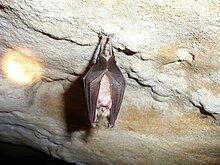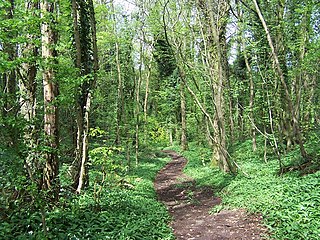Dean Hall Coach House & Cellar SSSI
| Site of Special Scientific Interest | |
 Example - Greater Horseshoe Bat (Rhinolophus ferrumequinum) | |
| Location | Gloucestershire |
|---|---|
| Grid reference | SO672130 |
| Coordinates | 51°48′54″N2°28′35″W / 51.815113°N 2.47649°W |
| Interest | Biological |
| Area | 0.02 hectare |
| Notification | 1988 |
| Natural England website | |
Dean Hall Coach House & Cellar (grid reference SO672130 ) is a 0.02-hectare (0.049-acre) biological Site of Special Scientific Interest in Gloucestershire, notified in 1988. [13] The site is listed in the 'Forest of Dean Local Plan Review' as a Key Wildlife Site (KWS). [14]
The hall (coach house and cellar) [15] is currently home to Greater horseshoe bats which makes it a Site of Special Scientific Interest which is closely monitored by Natural England. [2] It is a significant breeding roost and its use has been recorded since 1986. Local reports indicated that bats may have used the building for over 75 years. [7]
Location and habitat
The site is one of a series of Sites of Special Scientific Interest within the Forest of Dean and Wye Valley (Gloucestershire and Monmouthshire). These sites support (between them) breeding and hibernation roosts for Lesser and Greater horseshoe bats. This is of European importance. Other sites in the group in Gloucestershire (all of which are SSSIs) include the breeding sites of Blaisdon Hall, Caerwood And Ashberry Goose House, and Sylvan House Barn. Hibernation sites include Buckshraft Mine & Bradley Hill Railway Tunnel, Devil's Chapel Scowles, Old Bow And Old Ham Mines and Westbury Brook Ironstone Mine. [7]
The deciduous woodlands and sheltered valleys of the Forest of Dean and the Wye Valley provide a good feeding area, and the underground systems provide roosting and breeding sites. A ring of iron-ore bearing Carboniferous Limestone in the Forest of Dean has created a series of ancient and more recent mines which provide hibernation sites. The citations for the series of sites provide common information.
Wye Valley and Forest of Dean Bat Sites/ Safleoedd Ystlumod Dyffryn Gwy a Fforest y Ddena are recognised as a Special Area of Conservation (SAC) under the EU Habitats Directive. [16] [17]













